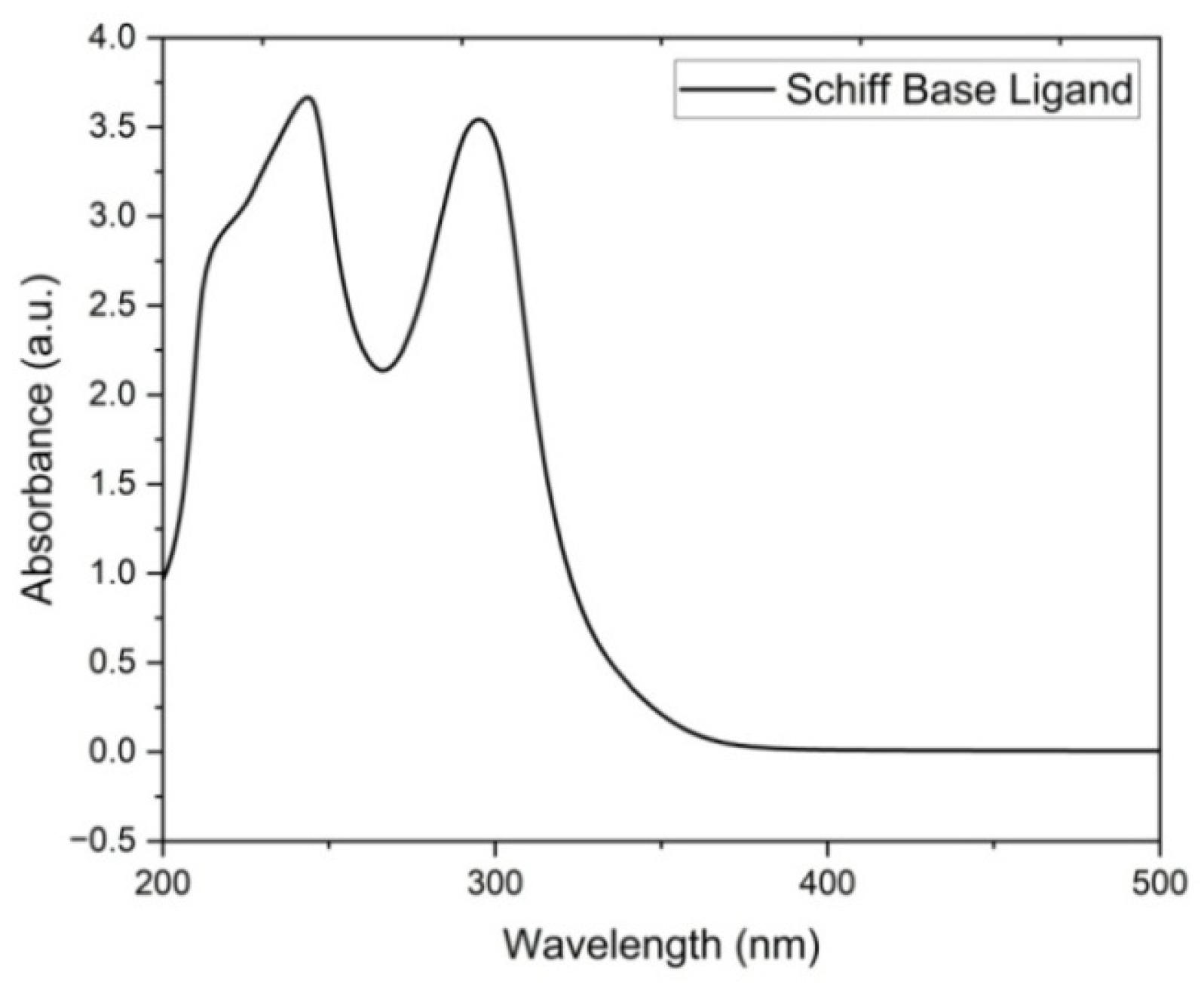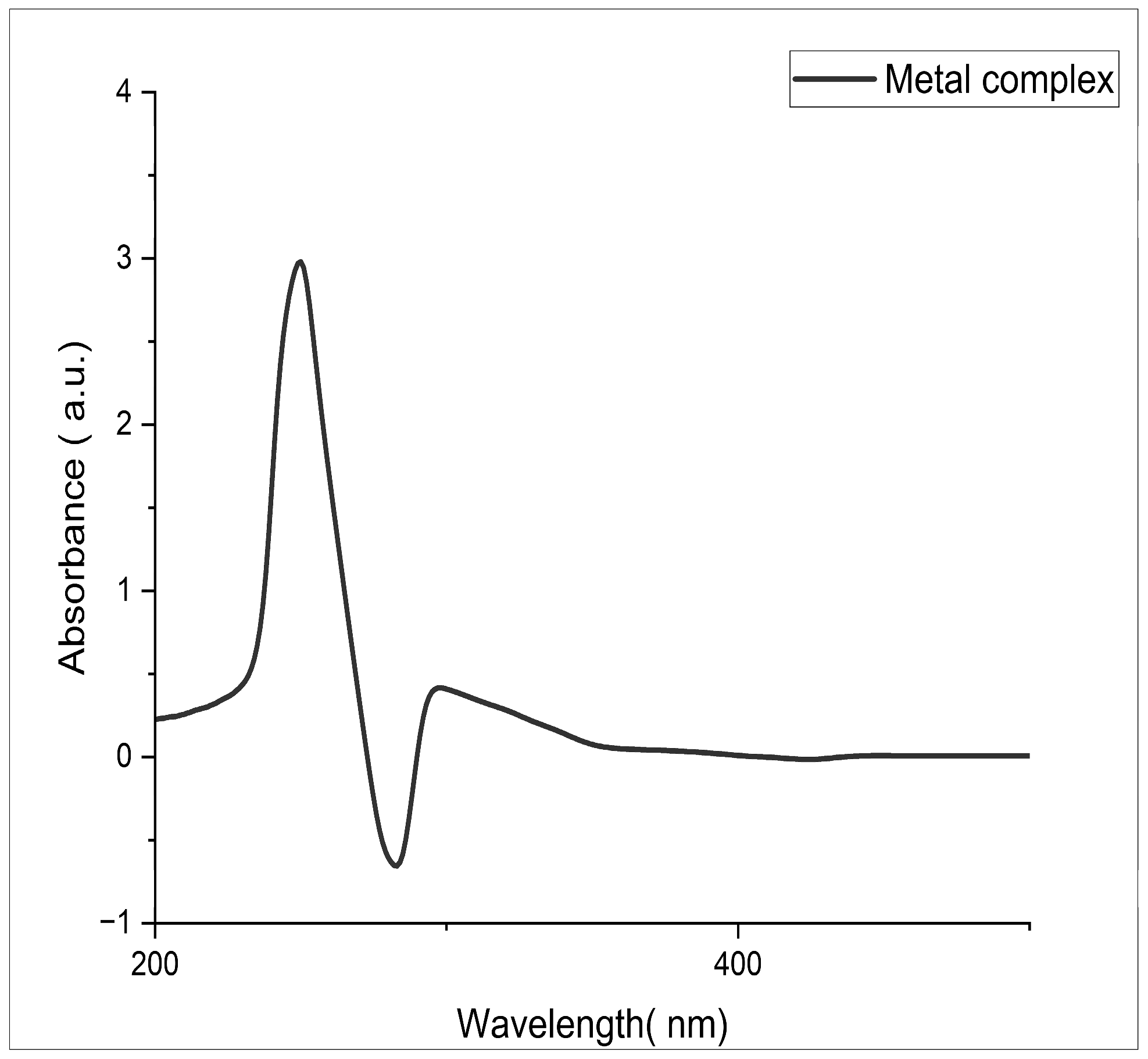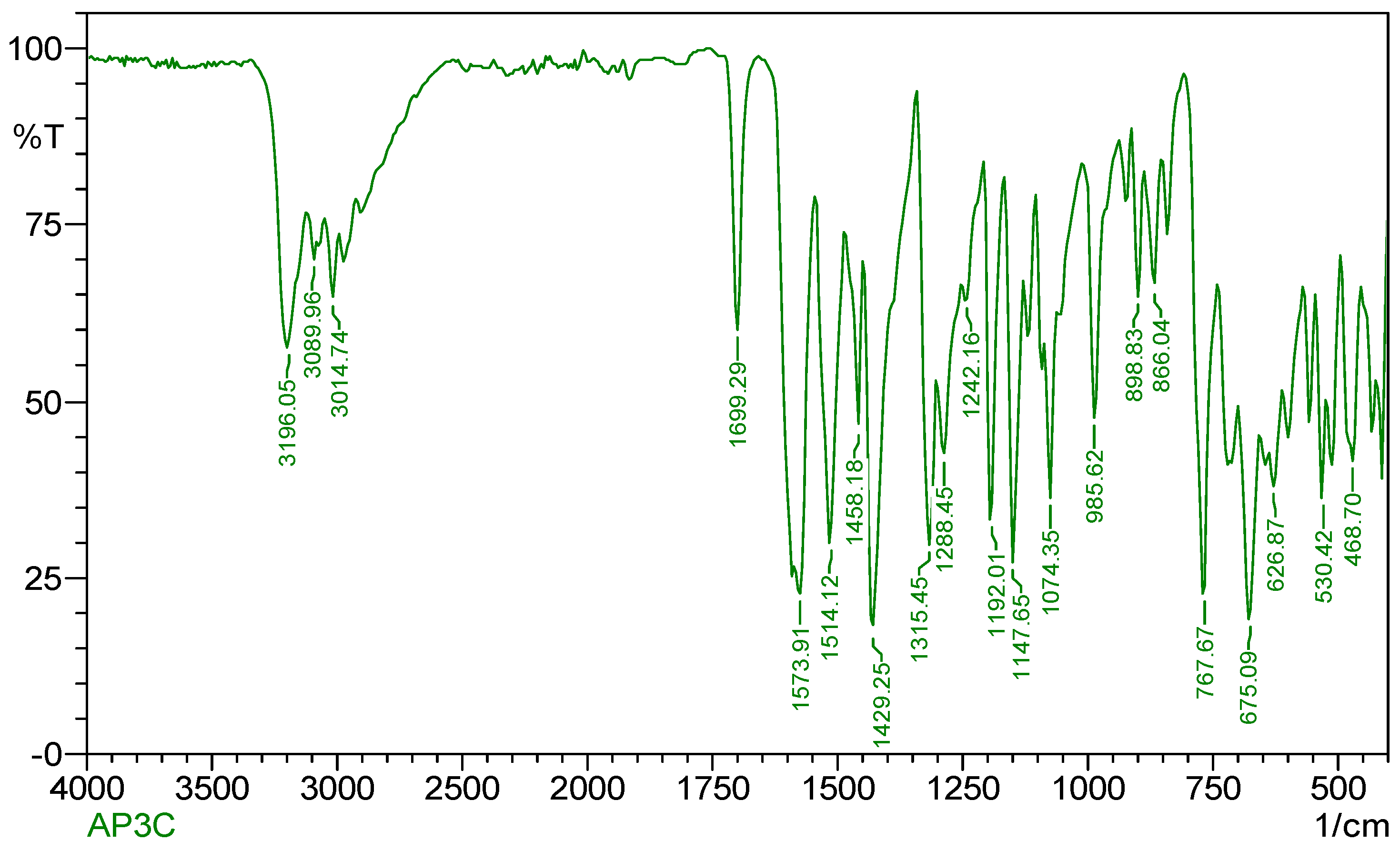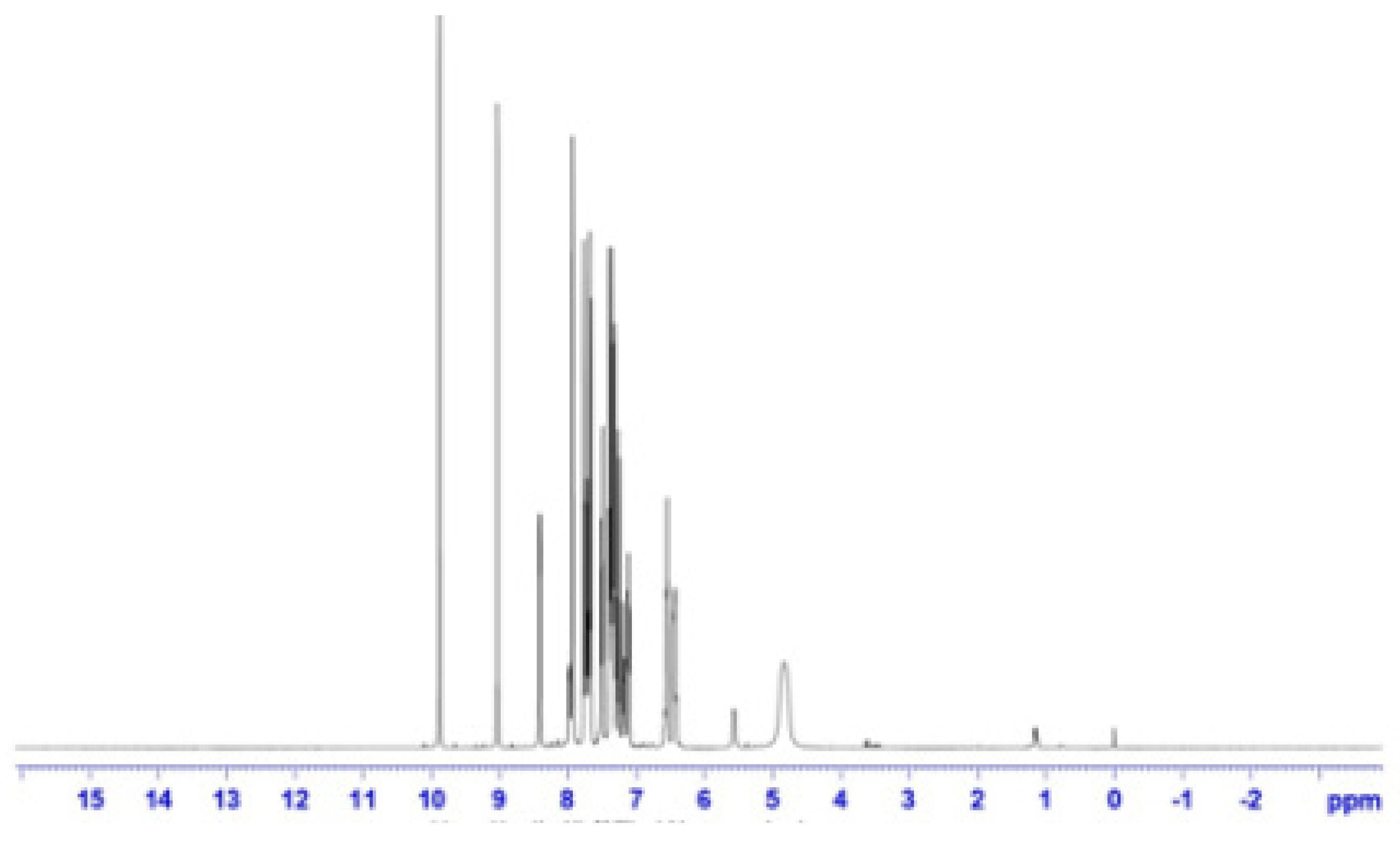Synthesis, Characterization, and Catalytic Applications of Schiff-Base Metal Complexes †
Abstract
1. Introduction
2. Experimental Methods
2.1. Materials and Methods
2.2. Instruments
2.3. Synthesis of Schiff-Base Ligand—1-(3-Chlorophenyl)-N-(pyridine-2-yl)methanimine [CPPM]
2.4. Synthesis of Schiff-Base Metal Complexes
3. Results and Discussion
3.1. Elemental Analysis
3.2. Electronic Spectral Study
3.3. IR Spectroscopic Study
3.4. 1HNMR Spectral Analysis
4. Catalytic Studies
5. Conclusions
Author Contributions
Funding
Institutional Review Board Statement
Informed Consent Statement
Data Availability Statement
Conflicts of Interest
References
- Vigato, P.A.; Tamburini, S. The Challenge of Cyclic and Acyclic Schiff Bases and Related Derivatives. Coord. Chem. Rev. 2004, 248, 1717–2128. [Google Scholar] [CrossRef]
- Patel, N.H.; Parekh, H.M.; Patel, M.N. Synthesis, characterization and biological evaluation of manganese (II), cobalt (II), nickel (II), copper (II), and cadmium (II) complexes with mono basic (NO) and neutral (NN) Schiff bases. Transit. Met. Chem. 2005, 30, 13–17. [Google Scholar] [CrossRef]
- Thakor, Y.J.; Patel, S.G.; Patel, K.N. Synthesis, Characterization and biocidal studies of some transition metal complexes containing tetra dentate and neutral bi dentate Schiff base. J. Chem. Pharm. Res. 2010, 2, 518–525. [Google Scholar]
- Ramesh, R.; Suganthy, P.K.; Natarajan, K. Synthesis, spectra and electrochemistry of Ru(III) complexes with tetradentate Schiff bases. Synth. React. Inorg. Met.-Org. Chem. 1996, 26, 47–60. [Google Scholar] [CrossRef]
- Enis, N.M.Y.; Thahira, S.A.; Edward, R.T.; Abhimanyu, V.; Karen, A.C.; Mohamed, I.M.; Haslina, A. Synthesis, characterization and Biological Evaluation of Transition Metal Complexes Derived from N, S Bidentate Ligands. Int. J. Mol. Sci. 2015, 16, 11034–11054. [Google Scholar]
- Pedreño, E.; López-Contreras, A.J.; Cremades, A.; Peñafiel, R. Protecting or promoting effects of spermine on DNA strand breakage induced by iron or copper ions as a function of metal Concentration. J. Inorg. Biochem. 2005, 99, 2074–2080. [Google Scholar] [CrossRef] [PubMed]
- Suja, P.S.; Theodore, S.; Antony, R.; Muthupoongodi, S.; Sathyasheeli, S. New class of Copper (II) complex derived from Isatin and Thiosemicarbazide—Synthesis, Spectral Characterization and biological activity. Pharma Chem. 2016, 8, 67–76. [Google Scholar]
- Yoon, T.P.; Jacobsen, E.N. Privileged Chiral Catalysts. Science 2003, 299, 1691. [Google Scholar] [CrossRef] [PubMed]
- Fernandez-G, J.M.; Lopez-Duran, F.A.; Hernandez-Ortega, S.; Gomez-Vidales, V.; Macias- Ruvalcaba, N.; Aguilar-Martínez, M. The structures and cyclic voltammetry of three copper (II) complexes derived from bulky ortho-hydroxy Schiff bases. J. Mol. Struct. 2002, 612, 69–79. [Google Scholar] [CrossRef]
- AKhandar, A.; Nejati, K. Synthesis and characterization of a series of copper (II) complexes with azo-linked salicylaldehyde Schiff base ligands. Polyhedron 2000, 19, 607–613. [Google Scholar] [CrossRef]
- Boulechfar, C.; Ferkous, H.; Delimi, A.; Djedouani, A.; Kahlouche, A.; Boublia, A.; Darwish, A.S.; Lemaoui, T.; Verma, R.; Benguerba, Y. Schiff bases and their metal Complexes: A review on the history, synthesis, and applications. Inorg. Chem. Commun. 2023, 150, 110451. [Google Scholar] [CrossRef]
- Gaur, S. Physico-chemical and Biological Properties of Mn(II), Co(II), Ni(II) and Cu(II) Chelates of Schiff Bases. Asian J. Chem. 2003, 15, 250–254. [Google Scholar]
- Gemi, M.J.; Biles, C.; Keiser, B.J.; Poppe, S.M.; Swaney, S.M.; Tarapley, W.G.; Romeso, D.L.; Yage, Y. Novel 1,5-diphenylpyrazole nonnucleoside HIV-1 reverse transcriptase inhibitors with enhanced activity versus the delavirdine-resistant P236L mutant: Lead identification and SAR of 3- and 4-substituted derivatives. J. Med. Chem. 2000, 43, 1034–1040. [Google Scholar]
- Lekha, L.; Raja, K.K.; Rajagopal, G.; Easwaramoorthy, D. Synthesis, spectroscopic characterization and antibacterial studies lanthanide (III) Schiff base complexes containing N, O donor atoms. J. Mol. Struct. 2014, 1056, 307–313. [Google Scholar] [CrossRef]
- Chohan, Z.H.; Supuran, C.T.; Scozzafava, A. Metalloantibiotics: Synthesis and Antibacterial Activity of Cobalt (II), Copper (II), Nickel (II) and Zinc (II) Complexes of Kefzol. J. Enzym. Inhib. Med. Chem. 2004, 19, 79–84. [Google Scholar] [CrossRef] [PubMed]
- Srinivasan, S.; Rajagopal, G.; Athappan, P.R. Synthesis, spectral and redox properties of metal complexes of macrocyclic tetraaza chiral Schiff bases. Trans. Met. Chem. 2001, 26, 588–593. [Google Scholar] [CrossRef]
- Toda, F.; Tanaka, K.; Hamai, K. Aldol condensations in the absence of solvent: Acceleration of the reaction and enhancement of the stereoselectivity. J. Chem. Soc. Perkin Trans. 1 1990, 3207–3209. [Google Scholar] [CrossRef]
- Doshi, A.G.; Ghiya, B.J. Synthesis and Antimicrobial Properties of Flavone Imines. Curr. Sci. 1986, 55, 502–503. [Google Scholar]
- Alcantara, A.R.; Marinas, J.M.; Sinisterra, J.V. Synthesis of 2′-hydroxychalcones and related compounds in interfacial solid-liquid conditions. Tetrahedron Lett. 1987, 28, 1515–1518. [Google Scholar] [CrossRef]
- Li, J.; Yang, W.; Wang, S.; Li, S.; Li, T. Improved synthesis of chalcones under ultrasound irradiation. Ultrason. Sonochem. 2002, 9, 237–239. [Google Scholar] [CrossRef] [PubMed]





| Compound | Empirical Formula | Color and Yield | M.Wt. | Analytical Data (%) | ||||
|---|---|---|---|---|---|---|---|---|
| C | H | N | Cl | M | ||||
| CPPM | C12H9ClN2 | Pale yellow (72%) | 216 | 66.5 | 4.2 | 12.9 | 16.4 | __ |
| Cu(CPPM)2.H2O | C25H23Cl2CuN4 | Bluish-green (78%) | 510.55 | 58.4 | 4.5 | 10.9 | 13.8 | 12.36 |
| Compound | Absorption, λmax | Band Assignments |
|---|---|---|
| Schiff-base ligand—CPPM | 212.63, 231.27, 311.67 | π-π*, n-π* |
| Cu(CPPM)2H2O | 311.67 | n-π* |
| Compound | ν(C=C) | ν(C=N) | ν(C-Cl) | νAr(C-H) | ν(N-C) | ν(M-N) |
|---|---|---|---|---|---|---|
| Schiff-base ligand CPPM | 1514.12 | 1699 | 767.67 | 3089 | 866.04 | - |
| Cu(CPPM)2H2O | 1523.31 | 1667 | 760.14 | 3011.72 | 852.67 | 530.42 |
| Compound Name | Catalyst | Product | Yield (%) |
|---|---|---|---|
| 1. Salicylaldehyde | KOH |  | 87 |
| PTSA | 67 | ||
| Metal Complex | 95 | ||
| 2. Anisaldehyde | KOH |  | 56 |
| PTSA | 78 | ||
| Metal Complex | 90 | ||
| 3. Benzaldehyde | KOH |  | 88 |
| PTSA | 82 | ||
| Metal Complex | 98 |
| Comp. No. | Compound Name | Melting Point (K) | Yield (%) | IR |
|---|---|---|---|---|
| 1 | C15H12O2 (E)-1-(2-hydroxyphenyl)-3-phenylprop-2-en-1-one | 467.72 | 95% | 1647.54(C=O), 1588.76(C=C), 3034.54 (aromatic C-H), 3210.01(C=C-H), 3321.89 (OH) |
| 2 | C16H14O2 (E)-1-(4-methoxyphenyl)-3-phenylprop-2-en-1-one | 402.02 | 90% | 2660.90(C=C stretch), 3300(C=C-H stretch), 1767.54(C=O), 1112.10(C-O-C), 3089.96(C-H aromatic) |
| 3 | C15H12O (E)-Chalcone | 356 | 98% | 1576.21(C=C), 1675.32(C=O), 3056.46(aromatic C-H) |
Disclaimer/Publisher’s Note: The statements, opinions and data contained in all publications are solely those of the individual author(s) and contributor(s) and not of MDPI and/or the editor(s). MDPI and/or the editor(s) disclaim responsibility for any injury to people or property resulting from any ideas, methods, instructions or products referred to in the content. |
© 2024 by the authors. Licensee MDPI, Basel, Switzerland. This article is an open access article distributed under the terms and conditions of the Creative Commons Attribution (CC BY) license (https://creativecommons.org/licenses/by/4.0/).
Share and Cite
Balachandran, G.; Dhamotharan, A.; Kaliyamoorthy, K.; Rajammal, K.S.; Kulandaiya, R.; Raja, A. Synthesis, Characterization, and Catalytic Applications of Schiff-Base Metal Complexes. Eng. Proc. 2024, 61, 26. https://doi.org/10.3390/engproc2024061026
Balachandran G, Dhamotharan A, Kaliyamoorthy K, Rajammal KS, Kulandaiya R, Raja A. Synthesis, Characterization, and Catalytic Applications of Schiff-Base Metal Complexes. Engineering Proceedings. 2024; 61(1):26. https://doi.org/10.3390/engproc2024061026
Chicago/Turabian StyleBalachandran, Gajalakshmi, Aswini Dhamotharan, Kiruthiga Kaliyamoorthy, Kalaivani Sivaramakrishnan Rajammal, Rajamani Kulandaiya, and Anthony Raja. 2024. "Synthesis, Characterization, and Catalytic Applications of Schiff-Base Metal Complexes" Engineering Proceedings 61, no. 1: 26. https://doi.org/10.3390/engproc2024061026
APA StyleBalachandran, G., Dhamotharan, A., Kaliyamoorthy, K., Rajammal, K. S., Kulandaiya, R., & Raja, A. (2024). Synthesis, Characterization, and Catalytic Applications of Schiff-Base Metal Complexes. Engineering Proceedings, 61(1), 26. https://doi.org/10.3390/engproc2024061026





